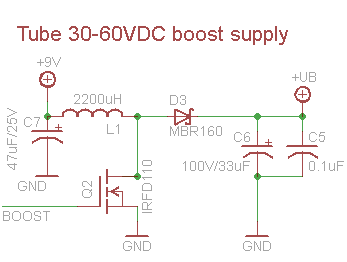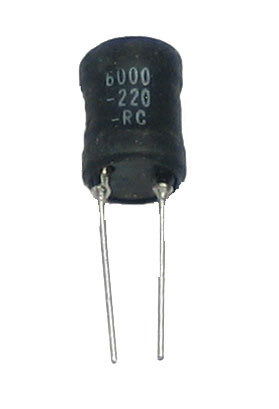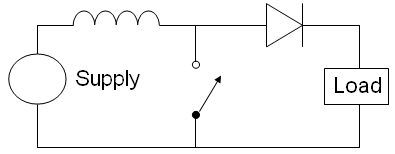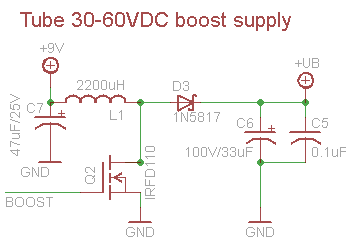High Voltage Boost Supply
http://learn.adafruit.com/ice-tube-clock-kit/design

Tubes such as VFDs, Nixies, Decatrons, etc require high voltage to light the gas in the tube. For nixies, this iabout 170VDC. VFDs aren't as bad they only need about 30-50VDC. In order to reduce cost, we use the microconrtoller to make a boost converter and avoid paying $5 for a seperate chip. We can do this because we don't need a precision output and the current draw is mostly constant. The boost regulator is run open-loop there is no feedback resistor divider as it isn't necessary as long as the input voltage is within a reasonable range.
The boost circuit works by connecting the power inductor L1 to ground that current can flow through it by turning on Q2. After a little bit of time, we disconnect the from ground (by turning off Q2) this means that there is no longer a path for the current in L1 to flow to ground. When this happens, the voltage across the inductor increases (this is the electric property of inductors) and charges up C6 . When the voltage increases to the level we want it to be (30V+) we turn on Q2 again which allows the current in L1 to flow back to ground. If we do this fast enough, and C6 large enough, the voltage on C6 is smoothed out and we get a nice steady high voltage.
The timing of turning off/on Q2 allows us to modify the output voltage. Normally there is a feedback resistor to the microcontroller but it is not here because we are running it open-loop. To drive Q2 we use the PWM output from the microcontroller and adjust the duty cycle to vary brightness.
- The voltage in is nominally 9 to 12VDC
- The current draw for the IV-18 tubes is about 8mA per digit and 11mA for the grid. Remember, though, that we only light up one digit at a time! So we need about 20mA total (we also meaured this in-circuit to verify)
- The voltage output is going to be between 30V-50V (its really much too bright after that point)
- The PWM output speed of the microcontroller is F_CPU / 256 = 8 MHz / 256 = 31.25KHz (period of 32 useconds)
With this information we can calculate the inductor size and capacity!
The optimal transfer between Vin and Vout is:
Vo/Vi = 1 / (1-D) where D is the duty cycle.
Solving for D = 1 - (Vi/Vo) and plugging in numbers:
For Vo = 50V and Vi = 9V, D = 82% (maximum)
For Vo = 30V and Vi = 12V D = 60% (minimum)
So the duty range will be between 60% and 82%. That would correspond to between ~150 and 220 out of 256, but note that when the PWM signal islow the switch is on so we need to invert that to a range of about 36 to 106 (in the code we actually use about 20 to 90).
OK so our PWM range is good, we just want to keep it between around 10% and 90% which we do.
Next, we need to make sure that the inductor continuously dumps current into C6 the entire time Q2 is off (continuous conduction mode). This is dependant on a lot of variables:
D*T*Vin/(2*L) < iout/(1-D)
Note that T is period time and is = 1/frequency. Solving for L, we choose the lowest duty cycle which will give us the upper bound for the inductor:
D*Vin * (1-D) / (freq * 2 * Iout ) < L
D = 60% (0.6)
iout = 20mA (0.02 Amp)
Vin = 12V nominal
1/T = freq = 31250 HzL > 0.6 * 12 * (1 - 0.6) / (31250* 2 * 0.02)
L > 2304 uH
This is our upper limit, so lets just say L = 2200uH (a standard value). Note that for 9V->60 we need L > 918uH which is our lower bound and our average case is a duty cycle of about 70% which is 1500uH.
We also want to make sure that we have a enough current capacity, so lets calculate the maximum current that builds up in the inductor. We now have to pick this for the -smallest- inductor, in the case of 9V boosting to 50V, an 82% duty cycle.
Ipk = (Vin * D)/(f * L)
Ipk = (9 * 0.82)/(31250 * .001) = 0.24 Amp
So! We want to make sure our inductor is > 2200 uH and will not saturate below 0.24 A.
The important thing to note here is that, for a given package (size) of inductor, the higher the inductance the lower the current capability.
Since this is a through-hole kit, we have to stick with a radial/axial inductor.

Searching Mouser for power inductors, we find the RLB9012 family (datasheet) which is the same type used in the mintyboost. This is a good inductor family, lets check out the range.

t looks like we're good to go with this group of inductors as the max current capacity of the 2200uH is well above our minimum 0.25 Any value higher than that will be OK as the Ipk will fall faster than the IDCmax
In reality, you don't need such high inductances because our system is not running on a battery and doesn't require a great power supply with low ripple and good efficiency. Inducances 270uH and lower worked just fine, the converter is operating in discontinuous mode which is not as efficient. Its also not as easy to calculate the precise specifications. Luckily this is a very indiscriminate tube and is cool with ripple and voltage fluctuations.
The diode is a schottky type, and needs to have a breakdown voltage larger than the maximum boost voltage (in this case 60V) we're usingMBR160 with 60V breakdown.
One way to improve the design to reduce the size and power requirements of the inductor is to increase the frequency. Doubling the frequency halves the required inductance and current requirements of the inductor!
I have a nice little calculator if you want to design your own basic boost converter
Thanks tons to Riad at jfet.org for the idea and calculations! (He has some great clock designs, so check them out)
For more information on boost converters see this article on wikipedia.
http://en.wikipedia.org/wiki/Boost_converter
A boost converter (step-up converter) is a DC-to-DC power converter with an output voltage greater than its input voltage. It is a class of switched-mode power supply (SMPS) containing at least two semiconductor switches (a diode and a transistor) and at least one energy storage element, a capacitor, inductor, or the two in combination. Filters made of capacitors (sometimes in combination with inductors) are normally added to the output of the converter to reduce output voltage ripple.

The basic schematic of a boost converter. The switch is typically a MOSFET, IGBT, or BJT.
http://learn.adafruit.com/diy-boost-calc
For many small projects, its cheaper and easier to DIY a boost converter than to buy a specialty chip. DIY converters are usually not as efficient but they're quick & cheap!

The above schematic section shows how I designed a 30-60V vacuum fluorescent tube display driven from a microcontroller pin.
Tubes such as VFDs, Nixies, Decatrons, etc require high voltage to light the gas in the tube. In order to reduce cost, we use a microconrtoller to make a boost converter and avoid paying $5 for a seperate chip. We can do this because we don't need a precision output and the current draw is mostly constant. The boost regulator is run open-loop there is no feedback resistor divider as it isn't necessary as long as the input voltage is within a reasonable range
The microcontroller runs at 8MHz so the 8-bit PWM output is 31250 Hz. The inductor and output capacitor is calculated below. The diode is a standard Schottkey type, but make sure you specify one that can handle the full voltage difference and peak current. The switch just has to be able to handle the max voltage plus some for safety. Note that this design is meant for 'static' output currents, not for variable current draw designs. There is no feedback and its very approximate! This is not for precision electronics!
The boost circuit works by connecting the power inductor L1 to ground that current can flow through it by turning on Q2. After a little bit of time, we disconnect the inductor from ground (by turning off Q2) this means that there is no longer a path for the current in L1 to flow to ground. When this happens, the voltage across the inductor increases (this is the electric property of inductors) and charges up C6 . When the voltage increases to the level we want it to be (30V+) we turn on Q2 again which allows the current in L1 to flow back to ground. If we do this fast enough, and C6 large enough, the voltage on C6 is smoothed out and we get a nice steady high voltage
The timing of turning off/on Q2 allows us to modify the output voltage. Normally there is a feedback resistor to the microcontroller but it is not here because we are running it open-loop. To drive Q2we use the PWM output from the microcontroller and adjust the duty cycle to vary brightness.
These sorts of designs can be easily made with a 555, once you have the PWM output, connect it up toQ2!
http://learn.adafruit.com/diy-boost-calc/the-calculator
http://learn.adafruit.com/downloads/pdf/diy-boost-calc.pdf
High Voltage Boost Supply的更多相关文章
- OpAmp Voltage Follower/Regulator
LDO Regulator High accuracy voltage regulator Vout = 2.5V * (1 + ( 5.6 / 6.8 ) ) = 4.55V Recently th ...
- OBD Experts OBD II Software OBD II Protocol Stack
http://www.obdexperts.co.uk/stack.html OBD II Software OBD Experts can provide you with ready to use ...
- 【转】linux设备驱动之MMC SD卡——核心层简单分析
原文网址:http://blog.chinaunix.net/uid-28685940-id-3889878.html /*************************************** ...
- An Isolated DAC Using PWM Output
An Isolated DAC Using PWM Output Arduino‘s (ATmega328P) PWM outputs via analogWrite can be convenien ...
- RF layout check list
Analog-digital circuit 1. Insure C36 and C33 placed next to each other to avoid open stubs 2. Keep U ...
- Use two picogate devices for bidirectional level-shifting
In new mixed-voltage systems, it is often necessary to level-shift a control signal from a high leve ...
- PatentTips - Integrated circuit well bias circuitry
1. Field of the Invention This invention relates in general to an integrated circuit and more specif ...
- Get just enough boost voltage - current-mirror circuit - VOUT tracks VIN varies
Adding a current-mirror circuit to a typical boost circuit allows you to select the amount of boost ...
- BOOST Converter Analog/Digital Adjusted Output Voltage TPS61045 MAX1932
DIGITALLY ADJUSTABLE BOOST CONVERTER The TPS61045 is a high frequency boost converter with digitally ...
随机推荐
- IOS使用SourceTree
一.安装sourceTree 1.下载 访问SourceTree 软件官方下载地址 : https://www.sourcetreeapp.com 下载macos版本 2.安装 安装和windows安 ...
- git —— 标签
标签:为分支添加一个可读标识. 1.创建标签 操作步骤: 切换到需要打标签的分支上 $ git branch $ git checkout master 为当前分支新增一个标签 $ git tag v ...
- thinkphp框架if标签条件表达式
eq 等于neq 不等于gt 大于egt 大于等于lt 小于elt 小于等于
- CxGrid 表格列内容居中
首先每一列 Cxgrid 都不知道要当成什么来出来,所以每一列都有个properties 让你来设置,告诉cxgrid 这列的内容是什么,然后根据你给出的内容 再来决定用什么居中方式: 就是说 官方再 ...
- numpy数学计算
1.求范数 np.linalg.norm norm(x, ord=None, axis=None, keepdims=False) 范数理论的一个小推论告诉我们:ℓ1≥ℓ2≥ℓ∞
- deploy.sh
备份一下之前的一个脚本吧 #!bin/bash adb uninstall org.cocos2d.fishingjoy4 for apk in `find . -name '*.apk' | xar ...
- Java项目中classpath路径
1.src不是classpath, WEB-INF/classes.lib.resources才是classpath,WEB-INF/是资源目录, 客户端不能直接访问. 2.WEB-INF/class ...
- python 判断字符编码
一般情况下,需要加这个: import sys reload(sys) sys.setdefaultencoding('utf-8') 打开其他文件编码用codecs.open 读 下面的代码读取了文 ...
- Jmeter和LR上传文件和下载
Jmeter和LR上传文件和下载 背景: 在某个申请业务中,需要上传附件文件,然后才能提交该申请 遇到的问题: 1, 在使用Jmeter或者LR进行录制时,无法录制到上传文件的请求,只能通过Fidd ...
- LogStash plugins-inputs-file介绍(三)
官方文档 https://www.elastic.co/guide/en/logstash/current/plugins-inputs-file.html 重要参数: path # 文件路径 sin ...
